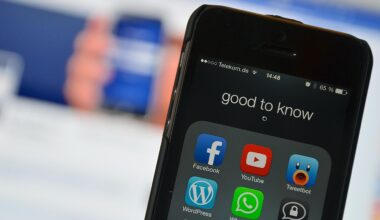Mastering In-App Messaging: Boost User Engagement Like Never Before
In today’s competitive app landscape, in-app messaging plays an essential role in keeping users engaged. These messages serve as powerful tools for communication, ensuring users feel connected to the app experience. Properly executed, in-app messaging can lead to higher retention rates, improved customer satisfaction, and ultimately better revenue. Through targeted messages, you have the opportunity to deliver personalized content that resonates with the user’s needs and preferences. As a strategy, it ensures that users are aware of new features, promotions, and updates, enhancing their overall experience. Furthermore, understanding user behavior through data analytics allows for more precise targeting. Customizing your messages based on user demographics can significantly increase the effectiveness and reception of your campaigns. Providing value through informative messages, reminders, or feedback requests encourages users to interact more with your application, pushing them to explore its full potential. By integrating an intuitive messaging strategy, you craft an environment that promotes continuous engagement and satisfaction with your app. Remember, understanding your audience is key. Applying insights will drive the crafting of effective in-app messaging strategies tailored specifically for your user base.
Understanding User Segmentation
Effective in-app messaging requires a deep understanding of user segmentation. Segmenting your audience based on behavior, preferences, and demographics allows for tailored communication strategies. By employing analytics tools, you can categorize users according to how they interact with your app. This segmentation empowers you to deliver messages that resonate with specific user groups, increasing engagement rates significantly. For instance, newly registered users may require onboarding messages that introduce them to app features. In contrast, long-term users might appreciate notifications about updates or loyalty rewards. Messaging isn’t one-size-fits-all; it should adapt based on where users are in their journey. Moreover, consider implementing A/B testing to refine your segmentation strategy further. Testing different messages across segments provides valuable insights into what resonates best with each group, allowing for continual improvement. Another critical aspect of segmentation is timing; sending messages at the right moment can make a significant difference. Leveraging data analytics ensures your messages land when they’re most impactful. By recognizing your audience and segmenting effectively, you can weave a narrative that keeps users engaged and informed throughout their journey within your app.
Crafting compelling content is central to successful in-app messaging. The messages you send should be engaging, clear, and purposeful, inviting users to take action. Start by focusing on the headline, as it’s essential in capturing attention quickly. A catchy and relevant subject line will entice users to read further. After that, ensure the body of your message is concise yet informative. Users appreciate brevity; delivering your message in a few key points helps maintain their interest. Including actionable tips or interesting insights can further drive engagement, prompting users to interact with your app features. Additionally, consider using visuals or icons to enhance your messaging visually. Images and graphics have the power to convey complex ideas simply and effectively, augmenting the written content. Furthermore, integrating user-generated content can build community and reliability. When users see messages involving their peers or fellow users, it boosts their confidence in engaging further. Testing different styles of content allows you to identify what resonates best with your users. Continuous iteration will help maintain high engagement levels and ultimately enhance user loyalty to your app.
Timing and Frequency of Messages
Timing and frequency play crucial roles in the success of in-app messaging strategies. It’s paramount to send messages at moments that are relevant and favorable for your users. Overwhelming users with too many messages can lead to disengagement or even uninstalls. Therefore, finding an ideal frequency for communication is essential. Start by analyzing user behavior to identify peak engagement times within your app. This data can help determine when to send messages for maximum impact. For instance, sending a promotional message during late evening hours may yield better results if users are most active at that time. Additionally, it’s wise to monitor user responses to adjust your messaging strategy accordingly. If users frequently ignore your messages, consider reducing frequency or altering content. Moreover, using automated triggers based on user actions can enhance timing efficacy. Automated messages can guide users through their journey, addressing specific actions taken. For example, if a user completes a tutorial, sending a follow-up message offering help can improve satisfaction. Balancing timing and frequency in your messaging strategy fosters a positive user experience while boosting engagement metrics significantly.
Personalization is an integral factor in increasing the effectiveness of in-app messaging. Users are more likely to engage with content that feels tailored to their interests and needs. By harnessing user data, such as previous interactions and preferences, you can customize messages that resonate personally. Addressing users by their names or referencing their past activities creates a sense of familiarity and connection. It’s also beneficial to segment your audience for more targeted personalization. For example, a user who regularly engages with fitness content may appreciate messages pertaining to new workout programs. Moreover, leveraging dynamic content allows for messages that adapt in real-time based on user actions. If a user has just completed a purchase, a thank-you message with a discount for future purchases can encourage return visits. Continuous analysis of engagement metrics helps refine your personalization strategies, ensuring they remain effective. However, while personalization is powerful, maintaining a balance is important. Avoid overwhelming users with excessive personalization, as it may come off as intrusive. Building a strategy that combines personalization with value adds meaningfully enhances user engagement, driving sustained interaction and loyalty.
Engagement Through Feedback
Incorporating user feedback into your in-app messaging strategy can drastically enhance engagement. Users appreciate when their opinions are valued, demonstrating that their input can directly influence app improvements. Prompting users for feedback through in-app surveys or rating requests offers an opportunity for dialogue. Ensure these requests are straightforward and provide users with an easy way to express their thoughts or suggestions. Moreover, incentivizing feedback through rewards or incentives can encourage more users to participate. Providing a quick and engaging method for giving feedback, such as through simple thumbs-up or thumbs-down responses, maintains user interest. Furthermore, actively responding to feedback fosters a sense of community and trust. When users see changes implemented based on their suggestions, it cultivates loyalty and encourages them to stay engaged with your app. Analyzing the feedback received can uncover insights into user preferences and pain points, enabling tailored improvements. Listening to users creates a dialog that promotes long-term engagement, as users feel part of the development process. Ultimately, embedding feedback mechanisms elevates in-app messaging from a monologue to a valuable conversation that enhances overall user experience.
Analyzing in-app messaging effectiveness is vital for continual improvement. Metrics such as open rates, click-through rates, and user engagement levels reveal the success of your messaging strategy. By closely monitoring these metrics, you can discern what works and where adjustments are needed. A/B testing different messages allows for experimentation to see which resonates better with your audience. It’s also essential to consider the qualitative feedback users provide. While quantitative metrics guide decision-making, qualitative insights into user sentiment enrich understanding. Analyzing patterns in user behavior post-message can reveal deeper insights into message impact. If users tend to drop off after specific messages, it may indicate a need for content or formatting adjustments. Leveraging analytic tools tailored for user engagement can simplify this process. Tools can offer comprehensive reports highlighting trends, successes, and areas for growth. Regularly reviewing these findings helps keep your messaging strategy relevant and engaging. Additionally, staying updated with industry trends and competitor strategies can provide new ideas. By combining data-driven analysis with creative iterations, your in-app messaging can evolve continually, offering optimum engagement and satisfaction for users.
Continuous enhancement of in-app messaging involves revisiting your entire strategy periodically. Adapting to emerging technologies and changing user dynamics is paramount in maintaining engagement levels. As user preferences evolve, your messaging should follow suit by incorporating new functionalities or content types. Consider incorporating video or interactive elements, as users increasingly engage with multimedia content. These enhancements can keep the messaging fresh and appealing. Moreover, observing competitor strategies can provide valuable lessons. By staying attuned to what others in your field successfully implement, you can adopt similar techniques or innovate beyond them. Continuous learning fosters creativity for devising engaging content that captivates users’ attention. Furthermore, setting long-term goals for your engagement strategy helps maintain focus and direction. Monitoring progress toward these goals can guide decision-making and strategy adjustments, ensuring their effectiveness over time. Regularly updating and refreshing content not only enhances user interest but also encourages users to return. Ultimately, an ongoing commitment to advancing in-app messaging solidifies your app’s place in the market, boosting engagement rates and customer loyalty in the long term.


